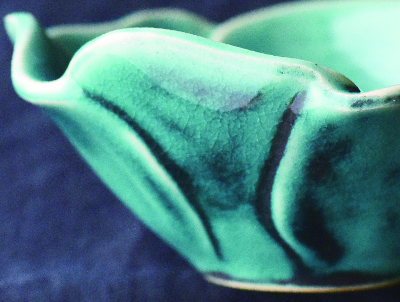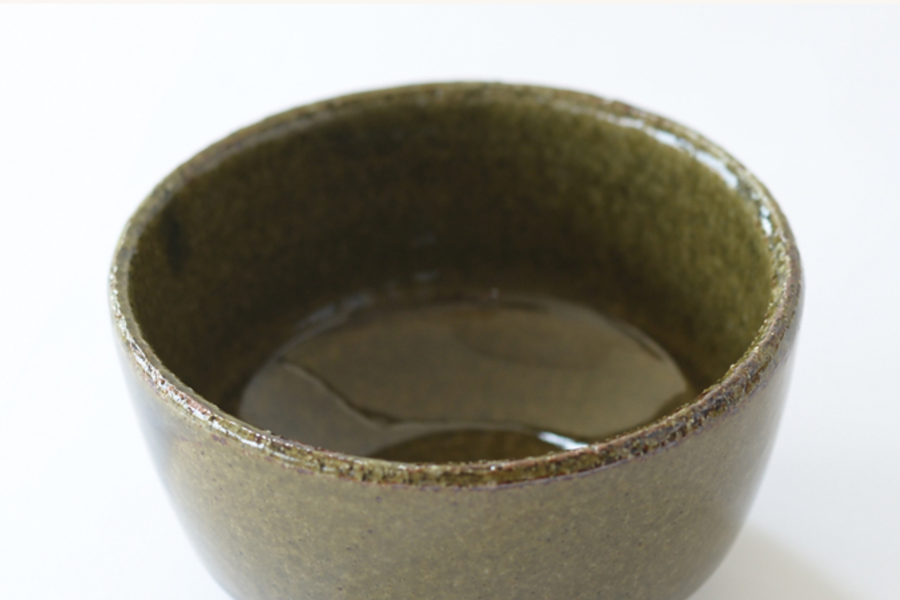当日発送について
以下の条件に該当するご注文を当日配送いたします。
・平日(営業日)の12時までにご注文が完了。
・ご注文いただいた商品の在庫がすべてある場合。
・お支払方法がクレジットカード決済か代引きの場合。
※受注状況や確認事項の有無などにより、お時間をいただく場合がございます。
※12時以降のご注文は最短で発送いたします。
定休日のご案内
土日祝日、お盆、年末年始などは出荷業務をお休みいたします。
Now Loading...
以下の条件に該当するご注文を当日配送いたします。
・平日(営業日)の12時までにご注文が完了。
・ご注文いただいた商品の在庫がすべてある場合。
・お支払方法がクレジットカード決済か代引きの場合。
※受注状況や確認事項の有無などにより、お時間をいただく場合がございます。
※12時以降のご注文は最短で発送いたします。
土日祝日、お盆、年末年始などは出荷業務をお休みいたします。
1 of 7
φ:直径 / W:幅 / D:奥行 / H:高さ / L:長さ
( )の数字は有効寸法です。
※多少の誤差が生じます。
容量:100cc
※多少の誤差が生じます。
○内容量表示は、満水の状態で計測しています。
○ポットの場合は水平に置いてこぼれない容量です。
○内容量表示は、概ねの目安として下さい。
器の使い始めは目止めの処理を推奨しております。
陶器は磁器や半磁器と比較して、吸水性が高いため汚れが染みやすく、稀に水が漏れる場合がございます。
お使いの用途に合わせて目止めを行ってください。
※目止めは、お料理の成分や汚れなどの吸収を軽減させる効果があります。 ただし、それらの吸収を完全に防ぐ効果はございません。
電子レンジはマイクロ波で食材を加熱します。多くの場合は水分を加熱しますが、炭化した(焦げた)部分にはマイクロ波が集中し、他の部分より温度が上がる場合があります。例えば野菜炒めの炭化した(焦げた)部分にマイクロ波が集中して、器の中で大きい温度差が生まれ、破損する場合があります。また、水分だけでなく油分も加熱されます。油分の方が水分より沸点が高く、より高温となり、油分の含まれた部分と含まれていない部分に非常に大きい温度差が生まれ、破損する場合もございます
○電子レンジご使用後の熱くなった器を水に浸したり、冷たい調理台に置いたりしないでください。また冷凍食品を入れて急激な加熱や、冷蔵庫から出した器をすぐに電子レンジに入れることはお止めください。急激な温度変化を与えると貫入や破損の原因となります。
※金・銀彩の上絵が施されている商品、特定の釉薬の商品には使用できません。使用できない商品にはシールが貼られていますのでご確認下さい
※付属品など陶磁器以外の素材については使用できません
食洗機使用不可表記ない商品につきましては、下記の項目を考慮の上ご使用下さい。
※食洗機内で器同士がぶつかると、破損する場合があります。
※殆どの陶磁器は水分を吸収します。表面上乾いた様に見えても、器の中には水分が残っている場合がございます。カビや匂いの発生の原因となるため食洗機使用後は速やかに取り出し、外気に触れる場所での十分な乾燥をするようにお願い致します。
商品の色に個体差があります。季節や気温などの自然条件や、釉薬と焼成する際の火加減によって、器は様々な表情を見せます。同じ素材の器であっても、まったく同じ色に焼きあがることは非常に珍しく、100個あれば、それぞれが違った表情を見せてくれます。

一個体の中で、釉薬や化粧土のムラがでます。1つの器の中において、色の表情が均一ではない箇所がある場合があります。器の形状などにより、釉薬の掛かり方が厚かったり、薄かったりする箇所があることが一つの要因です。それにより土の表情が一つの器のなかにおいても変化を見せます。

釉薬や化粧土が垂れたようになる場合があります。釉薬や化粧土を手作業でかけることによるムラや、焼成中の釉薬の流れにより、釉薬がたれた状態になります。

粒子の荒い土を使用しているため、小石の突起が生じたり、表面に凹凸がある場合があります。

商品の表面にピンホールが目立つ場合があります。土を主成分とする陶器には、素焼きの段階で器に多くの空気が含まれており、これが焼成時に気泡となって釉薬の表面に小さな穴となって現れます。これをピンホールといいます。

釉薬部分の細かなヒビが目立つ場合があります。直接貫入は商品に元々貫入が入っています。経年貫入は使用していくうちに入ってきます。素地と釉薬の収縮率の違いによって生じる釉薬部分のヒビのことです。商品本体の破損によるヒビとは異なります。使用前に生じることもありますが、使用上問題はありません。陶器、半磁器に現れます。

商品の表面に鉄粉が目立つ場合があります。陶器の原料となる土には鉄分が含まれており、器を焼くと表面に黒い点となって現れます。赤土や黒土にはより多く含まれているため、その土を利用した器は、より鉄粉が出やすくなります。

陶磁器は素材により取り扱いが異なります。マルミツポテリでは陶磁器の商品にはマテリアルナンバーシールを添付しております。長くご使用頂くために、取り扱いにはマテリアルナンバーの事柄にご注意お願いいたします。
○特性
器の使い始めは目止めをお勧めします。汚れやシミを付きにくくする効果があります。詳しくは目止めの仕方をご覧下さい。
器のベースとなる生地が非常に多孔質の上、表面に細かなヒビ(貫入)が入っているため、吸水性が非常に高く、食べ物や飲み物の水分がヒビから器の中に浸透し、さらには外側にまで出てくることがあります。繰り返しお茶を入れたり、料理に使うことで、粗い土の目にだんだん茶渋やでんぷん質などが詰まって外側への染み出しがなくなってきます。同時に、茶渋や料理の色が貫入や器に入り、器全体の色が変わってきます。使用しながら器の表情が変化していく様を楽しめる食器です。
上絵を施してある物は、金属たわし、クレンザー等の研磨剤のご使用は上絵を傷つけるおそれがございますので、お避け下さい。
ご購入時に表面に細かなヒビ(貫入)が入っているものや、使用していくうちに貫入が入っていくものがございますが使用上支障はありません。
○使用前
ご使用の際はその都度、たっぷりのきれいな水に浸して十分に吸水させて下さい。(30分以上が理想)食品の水分が入りにくくなりカビ、汚れの浸水を軽減させます。水に浸した際は、斑点のようなシミが出る場合があります。これは器が水分を吸水した為で、よく乾かして頂くと斑点は消えます。
○使用中
浸水後、熱い飲み物を入れた際に側面の貫入部分から器が吸水していた水分が、水滴状になって染み出てくることがあります。
○使用後
・長時間食品を入れたままでのご使用はお避け下さい。
・ご使用後はすぐに汚れを落とし、よく乾燥させてから収納して下さい。
※製造工程上、土のシワが目立つ場合があります。※焼成の度合いや釉薬の性質上、色ムラや焦げ感に個体差が生じます。
made in JAPAN
全ての商品はギフトラッピングが可能です。「ギフト」画面からギフトラッピングを商品と一緒にご注文ください。
※セット数や受注状況により発送までに多少お時間をいただく場合があります。お急ぎの場合はご相談ください。
GIFTご飯に味噌汁、主菜をプレートに盛りつけて、
最後のちょっとした一品は何の器にしよう、と思ったときに手にとりたくなるシンプルな小鉢。
土由来の素朴で温かな雰囲気と、テーブルに収まりのいいコンパクトなシリーズです。
たくさんの器が並ぶ、一汁三菜の食卓の中での使いやすさが特徴のシリーズ。
メイン料理を盛り付ける中皿や焼物皿をそっと引き立ててくれる、縁の下の力持ちのような存在です。
トヌレはフランス語で小樽という意味で、樽のように少し張り出した切立の形が由来。
柱型で少し高さのあるコンパクトな形がちょうどよく収まります。
縁はぽってりとさせ、側面に丸みをつけることで、切立型でも温かみを感じられるバランスです。
色は粉引、オリーブ、ビターの3色で、
どれも家庭料理をおいしく引き立てる組み合わせやすいカラー。

口元や側面の表情にも現れていますが、手に馴染む荒土のざらざらとした土の粒を楽しめる、
温かい雰囲気をまとった器です。

3.5寸鉢は納豆やおひたし、白和え、煮物などに。
2.5寸鉢には煮豆や珍味をちょこっと盛り付けて。
いつもの食卓を支えるおかずをトヌレに盛り付けてみませんか。